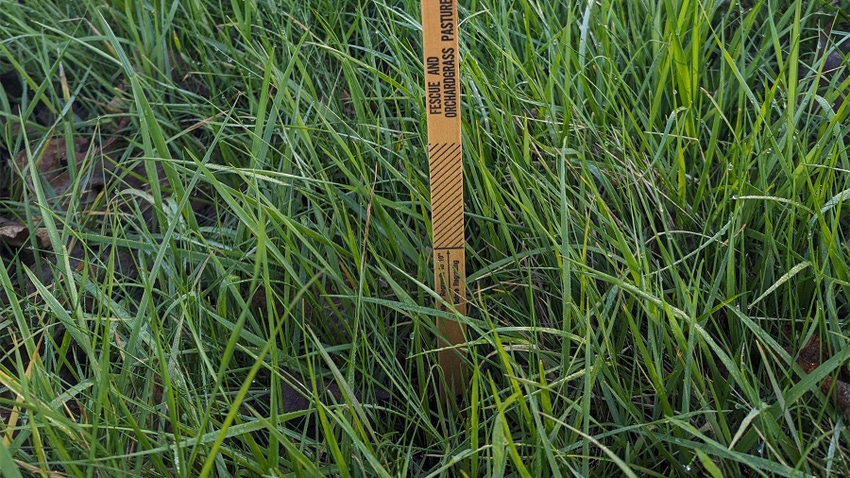April 17, 2024

by Christine Gelley
Measuring the amount of forage available for livestock to graze is a helpful task for designing and adjusting pasture rotations for grazing livestock.
There are many potential methods for measuring the amount of forage mass growing in a pasture. All of them require time spent in the pasture and repetitious measurements to develop estimations of whole pasture forage availability.
One of the simplest methods for estimating forage availability is using a grazing stick.
What does the grazing stick do?
A grazing stick combines information about forage height, forage density, species of forages growing in the pasture and residual grazing heights into a tool that looks like a yardstick.
By combining this information, the pasture manager can determine an estimate of available forage dry matter per grazing paddock. With additional information about animal intake, the manager can also calculate an estimate of how many days the paddock could be grazed before rotating to a new area.
Where can you find a grazing stick?
Grazing sticks are often available and distributed at events hosted by land-grant universities, soil and water conservation districts, forage and grassland councils, state agricultural departments, the Natural Resources Conservation Service, fairs, conferences, and more. To obtain a grazing stick, contact your local OSU Extension office or soil and water conservation district office.
Most states have their own customized version. There are grazing sticks designed for cool-season forage stands and warm-season forage stands. Most of the grazing sticks available in Ohio are for cool-season grasses.
A video of how to use a grazing stick, with Extension staff members Christine Gelley and Garth Ruff, can be viewed at go.osu.edu.
What are the steps for using the grazing stick?
Here are 11 steps for using the grazing stick:
Use the ruler side of the grazing stick to measure the height of the standing forage crop. Height should be measured where most of the forage touches the ruler. Lower your hand down onto the forage. The point where you meet resistance is the point where you should measure height. Record the height for later reference. Example: 10 inches.
Using the density side of the grazing stick, which has a grid with dots, set the grazing stick on the ground and slide it into the forage stand with the grid side up. Stand directly above the grazing stick and count the number of visible dots on the grid. Record the number of dots for future reference. Example: 2 dots.
Using the forage types and estimated pounds of dry matter per acre-inch that are printed on the stick and correspond with the number of dots visible on the grid, determine the estimated pounds of dry matter per acre-inch for the forages in your pasture. Record this value for the next step. Example: Orchardgrass and clover with two dots visible equals 300 pounds dry matter per acre per inch.
Determine how many inches of forage will be grazed, and how many inches will be left as residual when the animals rotate to a new area. The amount of residual necessary for regrowth depends on the type of forage. Grazing half and leaving half is a common method used and is often appropriate if the average forage height exceeds 6 inches. Example: Graze 5 inches. Leave 5 inches.
Multiply the number of inches to be grazed by the amount of dry matter available per acre-inch. Example: 5 inches x 300 pounds = 1,500 pounds of dry matter available per acre.
Repeat steps 1-5 at least 10 times (the more the better) to determine an average value for the paddock.
Calculate the acreage of your paddock multiplied by the dry matter available per inch. Example: 2 acres x 1,500 pounds = 3,000 pounds of dry matter available to graze in the paddock.
Estimate how many pounds of dry matter your animals will consume per day based on body weight. This amount will vary depending on the species, stage of life and energy demands of your livestock. Example: 1,000-pound animal x 2% of their body weight = 20 pounds of dry matter consumed per day. Example: 10 animals at 1,000 pounds each will consume 200 pounds of dry matter per day.
Divide the total dry matter available to graze by the total dry matter needed by the livestock per day to determine the estimated number of grazing days for the paddock. Example: 3,000 pounds of dry matter divided by 200 pounds of dry matter per day = 15 days of forage available.
Repeat steps 1-9 for the next paddock in the grazing rotation before turning animals in to graze.
Allow adequate rest time for forage to regrow before returning to graze again.
Gelly is the OSU Extension ag and natural resources educator in Noble County. She is also a member of the OSU Extension Beef Team that publishes the weekly Ohio BEEF Cattle letter, which can be found at beef.osu.edu.
Read more about:
GrazingYou May Also Like




